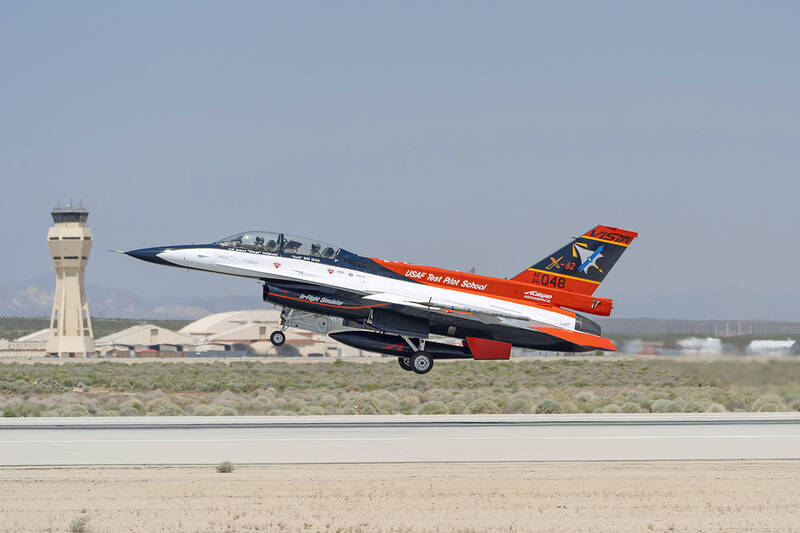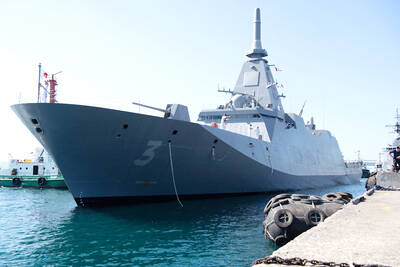With the midday sun blazing, an experimental orange and white F-16 fighter jet launched with a familiar roar that is a hallmark of US airpower, but the aerial combat that followed was unlike any other: This F-16 was controlled by artificial intelligence (AI), not a human pilot, and riding in the front seat was US Secretary of the Air Force Frank Kendall.
AI marks one of the biggest advances in military aviation since the introduction of stealth in the early 1990s, and the US Air Force has aggressively leaned in.
Even though the technology is not fully developed, the service is planning for an AI-enabled fleet of more than 1,000 uncrewed warplanes, the first of them operating by 2028.

Photo: AP
It was fitting that the dogfight took place at Edwards Air Force Base, a vast desert facility where Chuck Yeager broke the speed of sound and the military has incubated its most secret aerospace advances. Inside classified simulators and buildings with layers of shielding against surveillance, a new test-pilot generation is training AI agents to fly in war.
“It’s a security risk not to have it. At this point, we have to have it,” Kendall said after he landed.
The Associated Press, along with US broadcaster NBC, was granted permission to witness the secret flight on the condition that it would not be reported until it was complete because of operational security concerns.
The AI-controlled F-16, called Vista, flew Kendall in lightning-fast maneuvers at more than 885kph that put pressure on his body at five times the force of gravity. It went nearly nose to nose with a second human-piloted F-16 as both aircraft raced within 305m of each other, twisting and looping to try force their opponent into vulnerable positions.
At the end of the hour-long flight, Kendall climbed out of the cockpit grinning.
He said he had seen enough during his flight that he would trust the still-learning AI with the ability to decide whether or not to launch weapons in war.
Many oppose that idea. Arms control experts and humanitarian groups are deeply concerned that AI one day might be able to autonomously drop bombs that kill people without further human consultation, and they are seeking greater restrictions on its use.
“There are widespread and serious concerns about ceding life-and-death decisions to sensors and software,” the International Committee of the Red Cross has said, adding that autonomous weapons “are an immediate cause of concern and demand an urgent, international political response.”
Kendall said there will always be human oversight in the system when weapons are used.
The military’s shift to AI-enabled planes is driven by security, cost and strategic capability. For example, if the US and China should end up in conflict, the US Air Force’s fleet of expensive, crewed fighters would be vulnerable because of gains on both sides in electronic warfare, space and air defense systems.
The Chinese People’s Liberation Army Air Force is on pace to outnumber the US and it is also amassing a fleet of flying uncrewed weapons.
Future war scenarios envision swarms of US uncrewed aircraft providing an advance attack on enemy defenses to give the US the ability to penetrate an airspace without risking pilots’ lives.
The shift is also driven by money. The US Air Force is still hampered by production delays and cost overruns in the F-35 Joint Strike Fighter program, which would cost an estimated US$1.7 trillion.
Smaller and cheaper uncrewed AI-controlled jets are the way ahead, Kendall said.
Vista’s military operators say no other country has an AI jet like it, where the software first learns on millions of data points in a simulator, then tests its conclusions during actual flights. That real-world performance data is then put back into the simulator where the AI processes it to learn more.
China has AI, but there is no indication it has found a way to run tests outside a simulator.
Like a junior officer first learning tactics, some lessons can only be learned in the air, Vista’s test pilots said.
Until you actually fly, “it’s all guesswork,” US Air Force Test Pilot School chief test pilot Bill Gray said. “And the longer it takes you to figure that out, the longer it takes before you have useful systems.”
Vista flew its first AI-controlled dogfight in September last year, and there have only been about two dozen similar flights since. The programs are learning so quickly from each engagement that some AI versions getting tested on Vista are already beating human pilots in air-to-air combat.
The pilots are aware that in some respects, they might be training their replacements or shaping a future construct where fewer of them are needed.
They also say they would not want to be up in the sky against an adversary that has AI-controlled aircraft.
“We have to keep running, and we have to run fast,” Kendall said.

Nauru has started selling passports to fund climate action, but is so far struggling to attract new citizens to the low-lying, largely barren island in the Pacific Ocean. Nauru, one of the world’s smallest nations, has a novel plan to fund its fight against climate change by selling so-called “Golden Passports.” Selling for US$105,000 each, Nauru plans to drum up more than US$5 million in the first year of the “climate resilience citizenship” program. Almost six months after the scheme opened in February, Nauru has so far approved just six applications — covering two families and four individuals. Despite the slow start —

YELLOW SHIRTS: Many protesters were associated with pro-royalist groups that had previously supported the ouster of Paetongtarn’s father, Thaksin, in 2006 Protesters rallied on Saturday in the Thai capital to demand the resignation of court-suspended Thai Prime Minister Paetongtarn Shinawatra and in support of the armed forces following a violent border dispute with Cambodia that killed more than three dozen people and displaced more than 260,000. Gathered at Bangkok’s Victory Monument despite soaring temperatures, many sang patriotic songs and listened to speeches denouncing Paetongtarn and her father, former Thai prime minister Thaksin Shinawatra, and voiced their backing of the country’s army, which has always retained substantial power in the Southeast Asian country. Police said there were about 2,000 protesters by mid-afternoon, although

MOGAMI-CLASS FRIGATES: The deal is a ‘big step toward elevating national security cooperation with Australia, which is our special strategic partner,’ a Japanese official said Australia is to upgrade its navy with 11 Mogami-class frigates built by Japan’s Mitsubishi Heavy Industries, Australian Minister for Defence Richard Marles said yesterday. Billed as Japan’s biggest defense export deal since World War II, Australia is to pay US$6 billion over the next 10 years to acquire the fleet of stealth frigates. Australia is in the midst of a major military restructure, bolstering its navy with long-range firepower in an effort to deter China. It is striving to expand its fleet of major warships from 11 to 26 over the next decade. “This is clearly the biggest defense-industry agreement that has ever

DEADLY TASTE TEST: Erin Patterson tried to kill her estranged husband three times, police said in one of the major claims not heard during her initial trial Australia’s recently convicted mushroom murderer also tried to poison her husband with bolognese pasta and chicken korma curry, according to testimony aired yesterday after a suppression order lapsed. Home cook Erin Patterson was found guilty last month of murdering her husband’s parents and elderly aunt in 2023, lacing their beef Wellington lunch with lethal death cap mushrooms. A series of potentially damning allegations about Patterson’s behavior in the lead-up to the meal were withheld from the jury to give the mother-of-two a fair trial. Supreme Court Justice Christopher Beale yesterday rejected an application to keep these allegations secret. Patterson tried to kill her